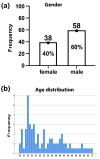Hematological Characteristics of Patients With Sickle Cell Disease in Al Ahsa, Saudi Arabia
- PMID: 40772168
- PMCID: PMC12327378
- DOI: 10.7759/cureus.87432
Hematological Characteristics of Patients With Sickle Cell Disease in Al Ahsa, Saudi Arabia
Abstract
Sickle cell disease (SCD) is an autosomal recessive illness characterized by severe morbidity and mortality rates. Although numerous studies on SCD have been conducted worldwide, the hematological features of SCD in the Middle East require further investigation. Therefore, we conducted this study to examine the hematological characteristics of SCD in Saudi Arabia, specifically in the Al Ahsa region. We performed a retrospective examination of health records at King Fahad Hospital in Hofuf, and data were analyzed in relation to gender, age, and other demographic factors. This study included a total of 96 records, with an average age of patients being 33 years. The majority of the patients (60%) were male. Most of the patients were anemic (99%), with one-quarter (26%) suffering from mild-to-moderate anemia (hemoglobin (Hb) above 10 g/dL) and the remaining three-quarters (74%) suffering from severe anemia (Hb below 10 g/dL). Correlation studies show that older patients (above 50 years old) are more severely affected by the disease compared to younger adult groups, evidenced by a strong negative correlation between age and both Hb levels and red blood cell counts (RBCs). Severe anemia is more common in females than in males, with a mean Hb of 8.4 g/dL in females (79% having Hb below 10 g/dL) compared to a mean Hb of 9.0 g/dL in males (71% having Hb below 10 g/dL). About half of the studied SCD population showed abnormal platelet counts (51%), with no significant difference between males and females. Thrombocytosis was slightly more prevalent than thrombocytopenia (31% vs. 20%). Our study indicates that SCD in Al Ahsa, Saudi Arabia, is associated with moderate-to-severe anemia. The impact of the disease is more pronounced in older individuals and females. Abnormal platelet counts are common among SCD patients in the Al Ahsa region. These findings should be taken into account when addressing SCD in the eastern province of Saudi Arabia and possibly in other regions.
Keywords: al ahsa; anemia; hematological characteristics; saudi arabia; scd; sickle cell crisis.
Copyright © 2025, Al Khamees et al.
Conflict of interest statement
Human subjects: Informed consent for treatment and open access publication was obtained or waived by all participants in this study. Al Ahsa Health Cluster’s IRB (H-05-HS-065) issued approval 02-E-2024. Al Ahsa Health Cluster’s IRB (H-05-HS-065) is pleased to inform you that your study mentioned below has been exempted from the full review on the basis of the approval from the IRB KFHH No. (H-05-HS-065), dated: 30-03-2023, with No: 21-EP-2023 This letter gives you ethical clearance to implement your study according to the approved documents, and you still need to obtain administrative approval from the site/s where the study will be conducted. Animal subjects: All authors have confirmed that this study did not involve animal subjects or tissue. Conflicts of interest: In compliance with the ICMJE uniform disclosure form, all authors declare the following: Payment/services info: All authors have declared that no financial support was received from any organization for the submitted work. Financial relationships: All authors have declared that they have no financial relationships at present or within the previous three years with any organizations that might have an interest in the submitted work. Other relationships: All authors have declared that there are no other relationships or activities that could appear to have influenced the submitted work.
Figures




Similar articles
-
Sickle Cell Disease.2003 Sep 15 [updated 2025 Feb 13]. In: Adam MP, Feldman J, Mirzaa GM, Pagon RA, Wallace SE, Amemiya A, editors. GeneReviews® [Internet]. Seattle (WA): University of Washington, Seattle; 1993–2025. 2003 Sep 15 [updated 2025 Feb 13]. In: Adam MP, Feldman J, Mirzaa GM, Pagon RA, Wallace SE, Amemiya A, editors. GeneReviews® [Internet]. Seattle (WA): University of Washington, Seattle; 1993–2025. PMID: 20301551 Free Books & Documents. Review.
-
Splenic sequestration crisis in children with sickle cell disease in the Eastern region of Saudi Arabia.BMC Pediatr. 2025 Sep 1;25(1):672. doi: 10.1186/s12887-025-06020-w. BMC Pediatr. 2025. PMID: 40887585 Free PMC article.
-
EORTC guidelines for the use of erythropoietic proteins in anaemic patients with cancer: 2006 update.Eur J Cancer. 2007 Jan;43(2):258-70. doi: 10.1016/j.ejca.2006.10.014. Epub 2006 Dec 19. Eur J Cancer. 2007. PMID: 17182241
-
Folate supplementation in people with sickle cell disease.Cochrane Database Syst Rev. 2018 Mar 16;3(3):CD011130. doi: 10.1002/14651858.CD011130.pub3. Cochrane Database Syst Rev. 2018. PMID: 29546732 Free PMC article.
-
Antioxidant supplementation for sickle cell disease.Cochrane Database Syst Rev. 2024 May 22;5(5):CD013590. doi: 10.1002/14651858.CD013590.pub2. Cochrane Database Syst Rev. 2024. PMID: 38775255 Free PMC article.
References
-
- Sickle cell disease: from genetics to curative approaches. Hardouin G, Magrin E, Corsia A, Cavazzana M, Miccio A, Semeraro M. Annu Rev Genomics Hum Genet. 2023;24:255–275. - PubMed
LinkOut - more resources
Full Text Sources
